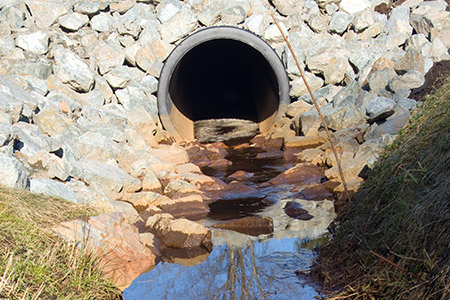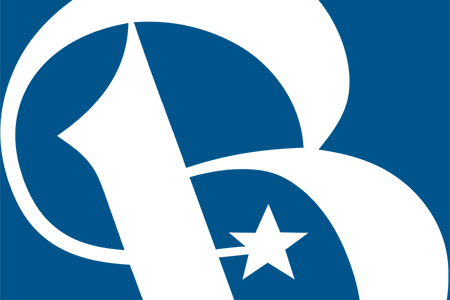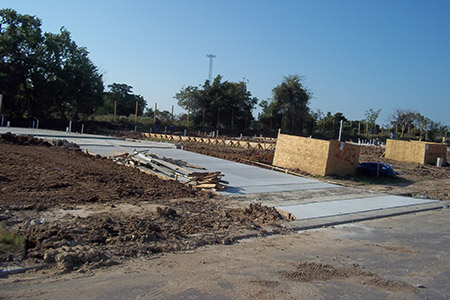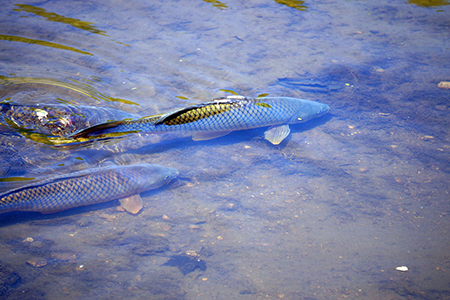Stormwater Management Program
What is Stormwater?
Stormwater is rain water or snow melt that runs across lawns, drive ways, parking lots, roofs and other surfaces. The runoff picks up pollutants such as trash, oil, chemicals, or dirt, that can be carried to Our creek, rivers, streams and lakes. These pollutants contaminate Our drinking water, or fish that we eat. It also causes fish and other aquatic life to die and it causes the cost of water treatment to increase.
Urban stormwater runoff is a serious concern. It is contaminated with pesticides, fertilizer, animal droppings, trash, food wastes, automotive by-products and other toxic substances that are part of our urban environment. Waters that flow over streets, parking lots, construction sites and industrial facilities carry these pollutants through a storm drain network directly to the lakes, streams and beaches of Texas.
Urban runoff is the largest source of unregulated pollution to the waterway and coastal areas of the United States. Locally, we see the impacts in increased health risks to swimmers near storm drains, high concentrations of toxic metals in ocean sediments and toxicity to aquatic life.
The City of Bryan has developed our Stormwater Management Program (SWMP) to comply with State and Federal regulations and to improve the quality of life in our city. The SWMP contains activities to reduce the amount of pollution in the stormwater that runs off to our waterways.
Stormwater Management Program
This plan is the third renewal of the City of Bryan’s Stormwater Management Program as required by the Texas Commission on Environmental Quality. This plan runs from 2019-2024 and is an update of the existing plan adopted in 2014.
Quick Links
- Stormwater Master Plan
- Stormwater Management Ordinance
- MS4 Annual Report
- Stormwater Management Plan
- Keep It Clean brochure, (Also available in Spanish)
What is the Difference Between Storm Sewer and Sanitary Sewer?
Sanitary sewers are connected by pipes to the area’s wastewater treatment plant, where it is treated to meet or exceed current EPA and TCEQ standards and then discharged.
Storm sewers collect stormwater runoff through storm drains and pipes. This water is carried to local creeks, rivers or lakes and is discharged untreated.
What You Can Do to Help
Report Issues
One way to get involved in protecting our water resources is through complaint reporting. By reporting sanitary sewer overflows, illegal dumping, and by using Household Hazardous Waste collection days to get rid of household chemicals.
Some other items that commonly make their way into our water ways are grass clippings, pet waste, trash, fertilizer, used motor oil, or even antifreeze, even plumbing is improperly connected to the storm drain system instead of to the sanitary sewer.
These improper connections can lead to fish kills, contamination to our drinking water or cause the water source to be harmful to humans and can spread disease.
You can report these types of issues to the city either by phone or online through the Help Bryan issue reporting system.
- Report a Stormwater Issue
- Illicit discharges: Contact Environmental Services at (979) 209-5900.
- Excessive sediment or erosion leaving a construction site: Contact Development Services at (979) 209-5030.
In Your Yard
- Applying fertilizer just before a storm is a big misconception. Fertilizer needs a day or two to sit. Otherwise, it will simply wash away into a storm drain where it negatively impacts the water quality and the environment. Follow the package instructions and apply only the amount indicated for your lawn’s size.
- Never use motor oil, gasoline, or kerosene to kill weeds and insects. These substances eventually wash away into our water resources.
- Use pesticides as a last resort and try less toxic alternatives. Some insects are actually a good thing.
- Plant native or adaptive plants. Texas Smartscape plants require less water and maintenance to thrive; and because they grow well in Texas, they rarely need help from pesticides.
- Use a cycle and soak method when watering your lawn. Our region’s predominate clay-like soil does not absorb water quickly. Add an hour between several shortened watering cycles to allow the water you are applying ample time to soak in rather than wastefully running off.
- Bag and dispose of your pet’s waste in a garbage can. Pet waste that remains on the lawn contains harmful bacteria that can wash into our waterways and ultimately our water resources. Pet waste is not a good fertilizer for your lawn.
- Sweep and collect your yard trimmings into a large paper bag designed for yard waste. Place the bags three feet away from your cart on your regularly scheduled pick up day. Never wash your yard trimmings into the street or in a storm drain. Clean storm drains help prevent localized flooding. City crews work to keep storm drains clear, but with thousands of drains in Bryan, we could use your help!
- Use a rain barrel to harvest the rain from your rooftop. You can collect and store the rain from a downspout in a collection device to use it on a future, sunnier day. A rain barrel rebate is offered by the Brazos Valley Groundwater Conservation District.
With Your Car
- Washing your car in the driveway allows soapy water to enter our water resources, but also oil, dirt and grime.
- Another alternative is taking your car to car washing facility where the water is recycled before and later sent to the sanitary sewer system for treatment.
- Repair your vehicle leaks as soon as possible to contain the negative impact that car fluids can have on the environment.
- Dispose or recycle your used oil, oil filters, and antifreeze at an auto service center where these items are collected. Your used motor oil and filters can be collected at the Environmental Collection Center, see here for details.
- Car batteries can be recycled at most of the automotive businesses or where car batteries are sold. There may be a fee for the service.
- Store any automotive parts in an area protected from the rain. This keeps remnants of oil and grease away from the ground and out of our storm drains.
On Your Boat
- Take extra precaution when using gasoline to avoid spilling it on the ground or in the water.
- Never toss your trash into the water. Decomposing litter is harmful to water quality and wildlife. Monofilament fishing line and plastic six-pack rings are particularly harmful to aquatic and bird life.
- Be sure to check your boat engine regularly and fix oil leaks promptly.
- Rather than using soap, rinse and scrub your boat with a brush. When soap is absolutely necessary, try using a phosphate-free and non-toxic soap in moderation. Plan ahead and consider places where you can wash your boat to avoid soapy water from entering and contaminating water resources.
- If you are removing paint from your boat’s hull, catch the scrapings in a drop cloth, or sweep and throw them away in the trash. Bottom paints may contain copper or tin which are extremely toxic to aquatic life and water quality.
How the City Handles Some of These Issues
- Map storm drain systems
- Conduct dry weather screening
- Investigate complaints of illegal dumping or illegal connections
- Hosting Household Hazardous Waste Collections
MS4 Annual Reports
On April 10, 2007 the City of Bryan adopted a Flood Mitigation Plan to create a strategy for implementing flood mitigation measures for the community. The plan identified several items for floodplain planning that the city has worked on implementing. These items include:
- Minimize losses due to flooding and achieve a balance between natural open space and improvements for drainage
- Preserve and protect unique open spaces, river corridors, drainage corridors and green spaces within the City and its Extraterritorial Jurisdiction
- Develop a network of pedestrian and bicycle ways for hiking and cycling throughout Bryan
Each year this progress report will be required as part of the City’s Community Rating System annual recertification process and must be provided to the Bryan City Council and made available to the news media and the public. The report will be produced on the City’s web page to facilitate this requirement. The intent of this report is to give a brief update on the City’s progress with respect to each of these items and to expand on the city’s future progress.
Stormwater Quality Outreach
Avoiding stormwater pollution takes everyone in the community to play his or her part in preventing pollutants from entering storm drain inlets where they live and work. You can help prevent stormwater pollution by becoming more aware of the issue, stopping harmful leaks and spills and reporting ones you see.
Improving Our Water Quality
This brochure is also available in Spanish.
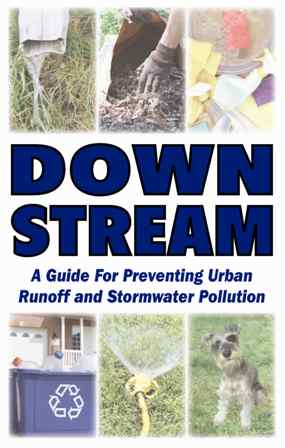
Construction Site Stormwater Runoff Control: Land Clearing and Construction Activities
Why is it important to monitor construction activities?
Dirt, materials and trash from construction and/or land clearing activities can be washed into the City’s drainage system. Remember, the drainage system is not a treatment system. These pollutants flow directly to local waterways where they can have a negative impact on water quality.
So, what’s the solution?
The solution is to keep dirt and trash on your site by having an adequate plan and simple devices in place to contain runoff.
The City of Bryan prohibits the discharge of pollutants to the City’s storm drain system. In order to comply with the Stormwater Management Ordinance, if your site meets certain criteria, you may need to apply for a Grading Permit and possibly a (TPDES) Construction General Permit.
The Texas Pollutant Discharge Elimination System (TPDES) Construction General Permit went into effect on March 5, 2003. The Texas Commission on Environmental Quality (TCEQ) is the permitting authority. The permit authorizes the discharge of stormwater associated with both large (greater than 5 acres) and small (greater than 1 acre but less than 5 acres) construction sites. The TPDES Construction General Permit as well as other necessary documents are provided below. Links to valuable information from TCEQ, EPA and other sources are also provided.
- General Permit for Construction Activities
- Notice of Intent (NOI)
- Notice of Termination (NOT)
- Large Site Notice
- Small Site Notice
Vegetation Requirements for Home Building Sites
This attached builder to homeowner transfer notice is a temporary option for the homeowner to take possession of the house until vegetation or other form of stabilization is installed. The homeowner transfer paper must be signed by the homeowner and the builder. It must specify the stormwater controls to be placed on the site to stop erosion. The site must be stabilized within two months of the date on the transfer. If the site is not stabilized within two months, the homeowner will be in violation of the City of Bryan and TCEQ requirements and may be subject to fines.
TCEQ Assistance
Additional Information
Construction Stormwater Management
Best Management Practices (BMPs) in this category are designed to address stormwater runoff from construction sites that are 1 acre or larger. Construction site operators are required by the Texas Commission on Environmental Quality (TCEQ) to develop a Stormwater Pollution Prevention Plan (SWPPP) and comply with regulations contained in the Construction General Permit. The City is required to implement ordinances and procedures to ensure that construction site operators comply with State regulations. The City will also educate and inform local developers and builders through a stakeholder committee and a training program.
Bryan’s Stormwater Management Program contains six BMPs in the Construction Site Stormwater Runoff Control category including:
- C-1 : Strengthen Erosion Control Ordinance
- C-2 : Erosion Control Plan Review Procedures
- C-3 : Construction Inspection
- C-4 : Developer’s Stakeholder Meetings
- C-5 : Construction General Permit Training
- C-6 : Stormwater Hotline for Public Comment
Often construction of a site begins with the removal of vegetation and grading of the site in preparation for building. In the case of sub-division development, large areas of bare soil may be exposed to rain during the construction phase. The lack of ground cover makes these sites especially vulnerable to soil erosion. Sediment laden water may be washed off-site and into streets, storm sewers, ponds, streams, and lakes, making the water cloudy. Besides poor visibility, the sediment prevents sunlight from reaching the aquatic plants and smothers bottom-dwelling insects and fish.
Post-Construction Stormwater Management
Best Management Practices (BMPs) in this category address stormwater runoff from areas of new development and redevelopment. Unlike the temporary BMPs during construction, post-construction BMPs are permanent and are used to control pollution after construction is completed. Post-construction BMPs should be incorporated into development projects and provide for the long-term operation and maintenance of post-construction BMPs.
Bryan’s Stormwater Management Program contains four BMPs in the Post Construction Stormwater Management category including:
- PC-1 : Developer’s Stakeholder Meetings
- PC-2 : Post Construction Ordinance
- PC-3 : Long Term Operation and Maintenance of BMPs
- PC-4 : List of Water Quality CIP Projects
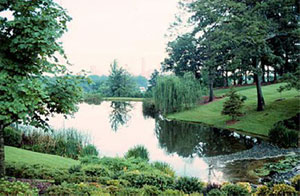
Numerous studies have documented that stormwater runoff from developed areas contributes significant amounts of pollution to lakes and streams. The increase in impervious surfaces such as rooftops, roads, and parking lots can increase urban runoff and have a detrimental impact on aquatic ecosystems due to increased concentrations of sediment, nutrients, pesticides, heavy metals, pathogenic bacteria, and petroleum hydrocarbons. The best way to reduce the negative effects of stormwater from new development is to use BMPs to treat, store, and infiltrate runoff onsite before it can affect downstream water bodies. Innovative site designs that reduce impervious area and low impact development practices may be used to reduce stormwater runoff and improve water quality.
City Inspection
The City of Bryan will inspect construction sites during construction and after construction has been completed to assure compliance with the Stormwater Management Ordinance.
- Stormwater Inspection Checklist
This checklist will be used to facilitate the inspection.
Please be aware that construction owners and operators will need to allow an Inspector of the City ready access for the sole purpose of inspection, surveillance and monitoring for the following:
- Access to NOI, Site Notice (i.e. Small or Large) and Stormwater Pollution Prevention Plan (SWPPP or SWP3) or Erosion Control Plan (ECP
- Evaluation of Best Management Practices (BMP’s)
- Illicit connections and discharge
- Overall compliance with City and State TPDES stormwater discharge permit
The City will inspect the construction site periodically or as requested upon complaint.
Builders / Contractors
Here is an example of a stormwater prevention plan for use in construction of new residential and commercial development.
Here are the TCEQ checklists for stormwater pollution prevention plans.
Here are Construction Control documents.
- Construction Control Selection Guide with Schematics
- Most-Used Construction Controls and Specifications
Vegetation Stabilization on Home Building Sites
Since 2003, the Texas Commission on Environment Quality (TCEQ) Construction General Permit TXR150000 has required final vegetation stabilization on home building sites in Bryan. These same requirements are also adopted in City of Bryan’s Code of Ordinances, Chapter 46, Stormwater Management. In recent years, TCEQ and the Environmental Protection Agency (EPA) have stepped up enforcement of these requirements, which has led to tens of thousands of dollars in fines for Texas home builders whose new home construction sites did not comply with Construction General Permit TXR150000. In order to help homebuilders and new homeowners in Bryan avoid becoming subject to state and/or federal fines for noncompliance with these adopted standards, the City of Bryan wants to help educate the development community about these requirements and offer assistance and advice on how to comply with these mandates.
In short, for the issuance of a Certificate of Occupancy on a new home site, all areas that were disturbed during the home construction need to be stabilized with vegetation. This includes adjacent lots that were used to access the building site during construction for any reason, e.g., to install fencing, laying brick or stone, or to simply access the building site. Homebuilders are encouraged to clear and disturb only those areas immediately essential for completing site construction. Site stabilizing measures should be implemented as soon as possible after the land is disturbed to help avoid soil erosion.
Vegetation stabilization options include:
- Sodding provides immediate stabilization or an area and should be used in critical areas or where establishment of permanent vegetation by seeding and mulching would be difficult. Sod can be planted in a checkerboard pattern so long as bare areas are less than 42 inches in diameter and no more than 30% of the to be stabilized area are left bare.
- Ground cover seeding and fertilizing. This may only be an option in very flat, non-sensitive areas with favorable soils.
- Xeriscaping, i.e. the process of landscaping that reduces or eliminates the need for supplemental water from irrigation.
- Low Impact Development (LID) stormwater management strategies that seek to reduce and/or prevent adverse runoff impacts through both nonstructural and structural techniques that preserve or closely mimic a site’s natural (pre-developed) response to precipitation.
Per the TCEQ’s Construction General Permit, once erosion controls are removed from the building site for irrigation or landscaping, vegetation stabilization has to occur no later than the end of the next business day. If sod is not a viable stabilization option at the time a Certificate of Occupancy is being sought, e.g. during hot summer months, then stormwater controls must remain in place to stop erosion until such time that sod can be installed and kept alive.
In order to relieve the homebuilder from the responsibility for maintaining stormwater controls once home construction is finished, the City of Bryan has developed a Builder to Homeowner Transfer Notice. This notice is a temporary option for the homebuilder to receive a Certificate of Occupancy and the homeowner to take possession of the house until vegetation or other form of stabilization is installed. The notice must be signed by the homeowner and the builder and must specify the stormwater controls that will be installed on the site within two (2) months, to stop soil erosion.
The Construction General Permit TXR150000 requires the City of Bryan to adopt a Stormwater Management Plan (SWMP) and submit an annual compliance report to TCEQ. The plan addresses how the City of Bryan handles pollution prevention, construction site stormwater runoff control, and post-construction stormwater management.
As mentioned above, ignoring stormwater management requirements may lead to state or federal fines for homebuilders, homeowners, or the City of Bryan, if not administered in accordance with the SWMP. Therefore, City of Bryan staff wants to help in any way we can to avoid penalties and assist homebuilders and homeowners in planning for, implement, and maintain useful stormwater management practices.
For additional information please see:
- Construction General Permit TXR150000
- Stormwater Pollution Prevention Plan requirements (explained above)
- Stormwater Requirements for Construction Activities
- Bryan Code of Ordinances, Chapter 46, Stormwater Management
- Best Management Practices
- Xeriscape Water Conservation (Aggie Horticulture)
Stormwater Frequently Asked Questions
The following frequently asked questions (FAQ) and answers have been designed to provide information to customers on the Stormwater Management Program:
What is stormwater?
Stormwater is rain that does not absorb into the soil and runs off of buildings, roads and other surfaces into stormwater systems, streams, creeks and rivers.
What is a Stormwater Management Program (SWMP)?
A SWMP is a plan that outlines how a city will reduce stormwater pollution. A SWMP consists of Best Management Practices that are grouped into six categories.
- Public Education and Outreach
- Public Participation and Involvement
- Illicit Discharge Detection and Elimination
- Construction Site Stormwater Runoff Control
- Post Construction Stormwater Management
- Pollution Prevention / Good Housekeeping for Municipal Operations
Why all the recent fuss about stormwater?
The Federal Clean Water Act requires large and medium sized towns across the United States to take steps to reduce polluted stormwater runoff. The law was applied in two phases. The first phase addressed large cities. The second phase, often referred to as ”Phase II,” requires medium and small cities, fast growing cities and those located near sensitive waters to take steps to reduce stormwater. These laws require chosen cities to create a Stormwater Management Plan to meet the requirements in the City’s permit.
Why did the City of Bryan develop a SWMP?
The City of Bryan developed a Stormwater Management Program (SWMP) to comply with State and Federal regulations and improve the quality of life in our city. The City’s SWMP contains activities or Best Management Practices (BMPs) to reduce the amount of pollution in the stormwater that runs off into our streams.
How do I find out what BMPs have been implemented and what BMPs will be implemented in the future?
The City’s SWMP is available online. The City produces an annual report, which is due to the Texas Commission on Environmental Quality (TCEQ) on November 10th each year. These annual reports outline the status of BMP implementation and describe what BMPs are anticipated for the next reporting cycle. The City’s annual reports are available on the Stormwater web page.
What is a Municipal Separate Storm Sewer System (MS4)?
The regulatory definition of an MS4 (40 CFR 122.26(b)(8)) is “a conveyance or system of conveyances (including roads with drainage systems, municipal streets, catch basins, curbs, gutters, ditches, man-made channels, or storm drains): (i) Owned or operated by a state, city, town, borough, county, parish, district, association, or other public body (created to or pursuant to state law) including special districts under state law such as a sewer district, flood control district or drainage district, or similar entity, or an Indian tribe or an authorized Indian tribal organization, or a designated and approved management agency under section 208 of the Clean Water Act that discharges into waters of the United States. (ii) Designed or used for collecting or conveying stormwater; (iii) Which is not a combined sewer; and (iv) Which is not part of a Publicly Owned Treatment Works (POTW) as defined at 40 CFR 122.2.”
In practical terms, operators of MS4s can include municipalities and local sewer districts, state and federal departments of transportation, public universities, public hospitals, military bases, and correctional facilities. The Stormwater Phase II Rule added federal systems, such as military bases and correctional facilities by including them in the definition of small MS4s.
What types of pollution are found in stormwater?
A: Some of the most common contaminants that are found in stormwater are listed below. For more information see About Stormwater.
- Sediment from eroded soil and construction sites
- Excess nutrients from lawn fertilizers
- Excess organic matter from leaf and grass clippings
- Bacteria and disease causing organisms from pet waste or raw, untreated sewage
- Debris /Trash such as plastic bags, cans, bottles, and cigarette butts
- Household chemicals like insecticides, pesticides, paint, solvents, used motor oil, and other auto fluids
- Metal particles deposited on roadways from automobiles
Are sewers and storm drains the same thing?
No. They are two completely separate drainage systems. Effluent in the sewer system receives extensive and thorough filtration prior to being discharged. The storm drain system on the other hand, receives no filtration whatsoever, and discharges directly into the local creeks untreated.
Why doesn’t the City build a stormwater treatment facility?
Such a facility would be extremely costly to build and maintain. And, the massive amount of water coming through the facility during a rainstorm would easily overtax the system.
Where does my stormwater go?
Stormwater runoff from Bryan flows to one of the following creeks:
- Briar Creek
- Burton Creek
- Carter’s Creek
- Cottonwood Creek
- Still Creek
- Thompson’s Creek
- Turkey Creek
If it only affects streams and creeks, why should I care?
Streams and creeks feed into rivers, lakes and eventually the ocean. We all drink water, so we are all affected when our water is polluted. When water treatment costs rise, the price of drinking water goes up. If you like to fish, swim or boat, you may have heard or been affected by advisories warning you not to swim, fish or boat in a certain area because of unhealthy water or too much algae. Shellfish like clams, oysters, and shrimp cannot be harvested from polluted waters, so anyone that enjoys these foods or makes a living from the shellfish industry is affected. Money made from tourism and water recreation can also be impacted, as are businesses and home flooded by stormwater runoff. When we pollute our water, everyone is affected!
Can I dispose of used motor oil on the ground or in the garbage?
NEVER dispose used motor oil on the ground; in a ditch, creek, river, or lake; in a storm drain; or in the garbage. It’s against the law. Texas law prohibits dumping used oil on land or into sewers or waterways. Texas has also banned used oil filters from being placed in or accepted for disposal in a landfill.
Why is used motor oil so harmful?
One oil change – improperly disposed and not recycled – can contaminate one million gallons of fresh water, which is a year’s supply for 50 people.
Where can I take my used motor oil?
The City encourages citizens to take their used motor oil to the Municipal Services Center (1111 Waco Street) or to any local auto maintenance shop in Bryan. These auto shops are conveniently located and will take the used oil free of charge. Quantities of less than five gallons from non-commercial users will be accepted at any auto service shop. For the location of a used oil/used oil filter collection center near you, call 1-800-CLEANUP, or visit Earth911.org to search for recycling locations by Zip Code.
What are Household Hazardous Chemicals?
Many common household chemicals are dangerous to our kids, pets, and the environment. These materials may pollute our waterways if washed or dumped into storm drains or roadside ditches that lead directly to our streams and lakes. Household cleaners, pesticides, gasoline, antifreeze, used motor oil, and other hazardous products should to be labeled, stored, and disposed of properly.
Where can I dispose of Household Hazardous Chemicals?
The City provides free disposal of household hazardous chemicals to its residents. See the Household Chemical Disposal web page for disposal procedures or Bryan’s Environmental Services Department web page for safer alternatives.
Can leaves and grass clippings go in the storm drain?
No. Even though leaves and grass are natural and biodegradable, these organic materials consume oxygen when they decompose and remove dissolved oxygen from the water. Fish and other aquatic organisms require oxygen and will die in the absence of oxygen.
Who do I call if I see anyone illegally dumping into the storm drain?
Call the City of Bryan’s Stormwater Hotline at (979) 209-5900 to submit an anonymous report if you observe any of the following:
- Illegal dumping of trash and debris along roadways or in creeks
- Leaking automobiles
- Concrete dumped in the street or storm drain
- Paint dumped in storm drain
- Motor oil dumped in storm drain
- Sediment runoff from construction sites
- Yard clippings blown or swept into storm drains
- Sewage or septic tank leaks
I am looking for volunteer opportunities. How can I become involved in stormwater management activities?
Stream cleanup projects are a great way to improve aquatic habitat, water quality, and aesthetics while promoting stormwater awareness. You can help keep our streams healthy by participating in Stream Cleanup projects or Storm Drain Marking events. The City is looking for volunteer organizations to participate in stream cleanup or to help glue markers on storm drain inlets. Individuals, businesses, civic organizations, Girl/Boy Scout troops, schools, neighborhood and homeowner associations are invited to participate in these efforts.
What does impervious mean?
Impervious is defined as a surface that does not absorb water. Several examples of impervious areas include asphalt or concrete pavement, parking lots, driveways, sidewalks and buildings.
What are some of the city’s challenges in managing stormwater?
As rain falls on agricultural and undeveloped areas, it is primarily absorbed into the ground or slowly runs off into streams, rivers or other bodies of water; however, development including buildings and paved areas blocks the water from being absorbed. Having a stormwater management program allows the city to better maintain the drainage system. The primary stormwater management challenges include:
- Increased sources of stormwater pollution
- Erosion along creeks and streams
- Sedimentation in water ways
- Localized flooding
- Debris in creeks and streams
- Maintaining infrastructure
Stormwater can carry contaminants such as plastic bags, detergents, heavy metals and pollution that can be harmful to the environment. In addition, erosion can contribute to the contaminants in stormwater runoff, as well as damage residential and commercial property. Debris that is swept into creeks and waterways during storm events can prevent the proper movement of stormwater, increasing the risk of flooding.
What is the City doing to minimize the impact of stormwater?
The City of Bryan has a number of programs that specifically target the problems associated with stormwater.
- Inspection and Prevention: City staff inspects and monitors construction sites to ensure proper controls are in place to minimize runoff.
- Planning and Engineering: City engineers review design and construction plans for the impact of stormwater.
- Infrastructure Construction and Maintenance: City engineers and maintenance crews work to design new stormwater infrastructure and to maintain existing stormwater infrastructure.
